Strategic Management Analysis of Abercrombie & Fitch: Course Report
VerifiedAdded on 2023/01/13
|21
|5783
|40
Report
AI Summary
This report conducts a comprehensive strategic management analysis of Abercrombie & Fitch, addressing various aspects outlined in the provided case study. It begins with a PESTEL analysis to assess the external environmental factors impacting the company. The report then identifies and analyzes the major driving forces within the industry, followed by an examination of Porter's Five Forces to evaluate the competitive landscape. Key success factors are identified and ranked. A competitive strength assessment and a strategic group map are also included to understand the company's positioning relative to its competitors. The report evaluates the attractiveness of the industry and provides a financial overview of the company's profitability, liquidity, and growth. Furthermore, the report assesses Abercrombie & Fitch's value chain, identifies its competitive advantages through a resource-based view, and conducts a SWOT analysis. The report concludes with an assessment of the company's mission and business model, generic strategy, and strategic issues, offering recommendations for short-term, medium-term, and long-term strategies to address these issues and improve the company's performance. The analysis covers all the questions outlined in the case study, providing a detailed and insightful assessment of Abercrombie & Fitch's strategic situation.
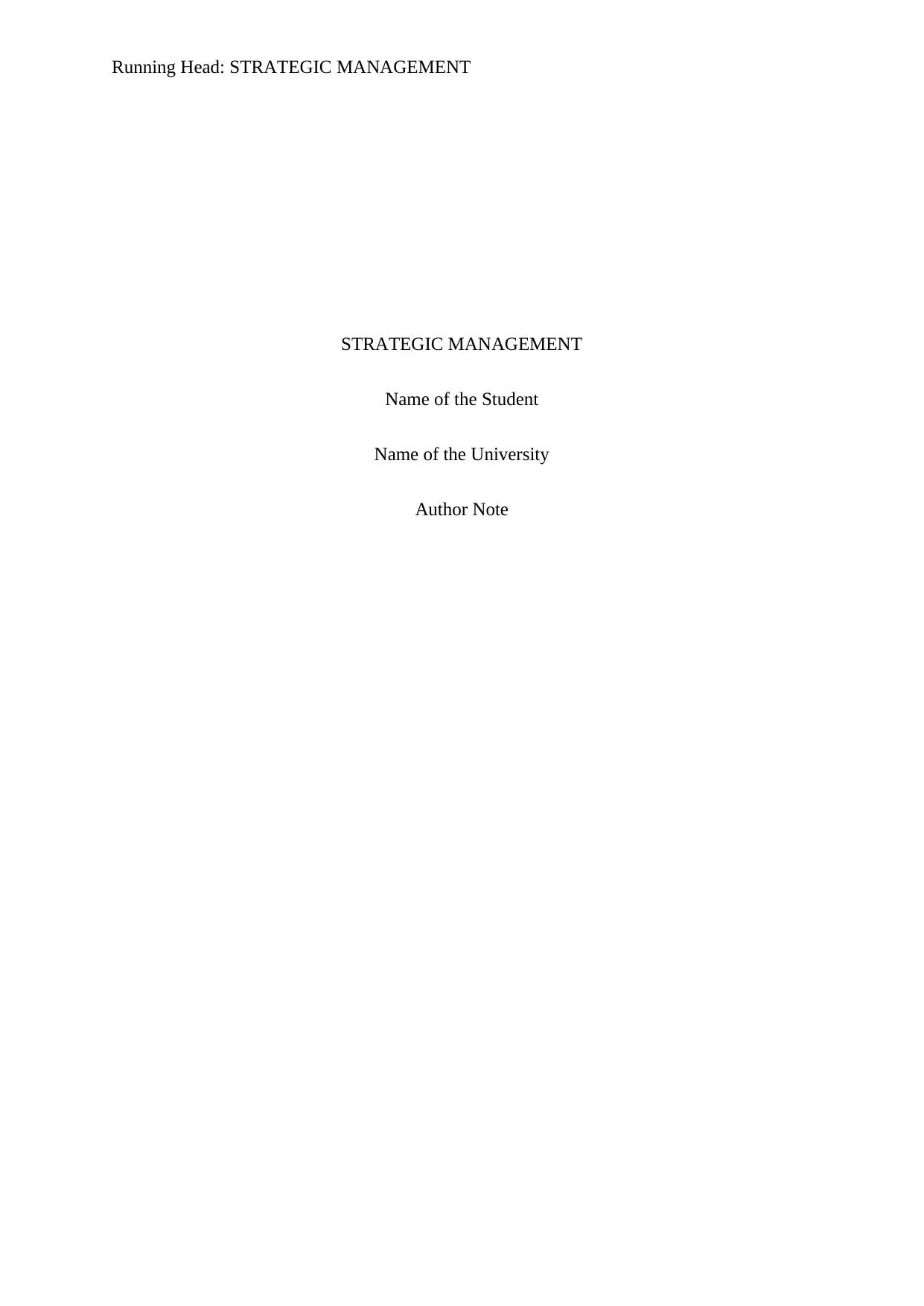
Running Head: STRATEGIC MANAGEMENT
STRATEGIC MANAGEMENT
Name of the Student
Name of the University
Author Note
STRATEGIC MANAGEMENT
Name of the Student
Name of the University
Author Note
Paraphrase This Document
Need a fresh take? Get an instant paraphrase of this document with our AI Paraphraser
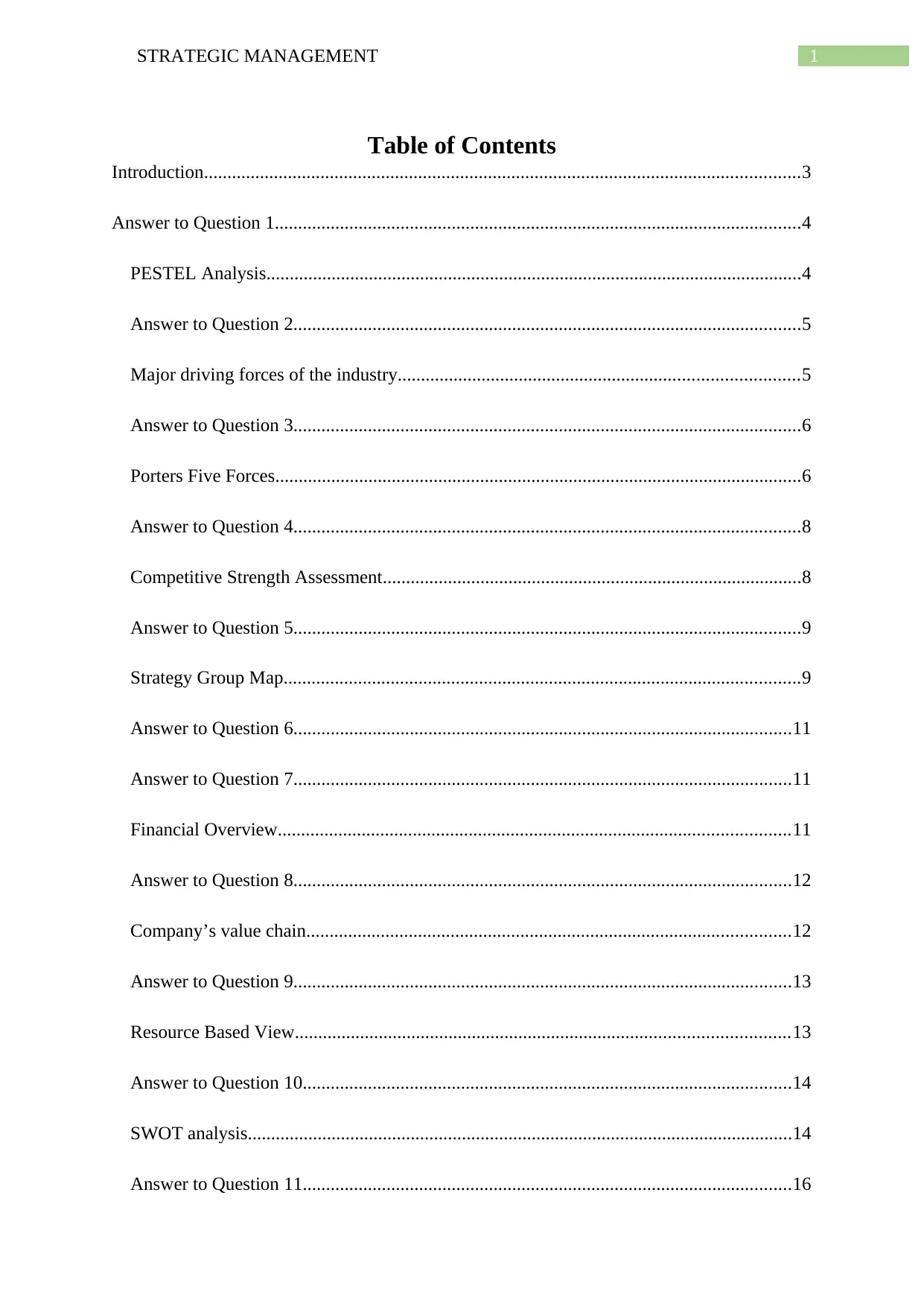
1STRATEGIC MANAGEMENT
Table of Contents
Introduction................................................................................................................................3
Answer to Question 1.................................................................................................................4
PESTEL Analysis...................................................................................................................4
Answer to Question 2.............................................................................................................5
Major driving forces of the industry......................................................................................5
Answer to Question 3.............................................................................................................6
Porters Five Forces.................................................................................................................6
Answer to Question 4.............................................................................................................8
Competitive Strength Assessment..........................................................................................8
Answer to Question 5.............................................................................................................9
Strategy Group Map...............................................................................................................9
Answer to Question 6...........................................................................................................11
Answer to Question 7...........................................................................................................11
Financial Overview..............................................................................................................11
Answer to Question 8...........................................................................................................12
Company’s value chain........................................................................................................12
Answer to Question 9...........................................................................................................13
Resource Based View..........................................................................................................13
Answer to Question 10.........................................................................................................14
SWOT analysis.....................................................................................................................14
Answer to Question 11.........................................................................................................16
Table of Contents
Introduction................................................................................................................................3
Answer to Question 1.................................................................................................................4
PESTEL Analysis...................................................................................................................4
Answer to Question 2.............................................................................................................5
Major driving forces of the industry......................................................................................5
Answer to Question 3.............................................................................................................6
Porters Five Forces.................................................................................................................6
Answer to Question 4.............................................................................................................8
Competitive Strength Assessment..........................................................................................8
Answer to Question 5.............................................................................................................9
Strategy Group Map...............................................................................................................9
Answer to Question 6...........................................................................................................11
Answer to Question 7...........................................................................................................11
Financial Overview..............................................................................................................11
Answer to Question 8...........................................................................................................12
Company’s value chain........................................................................................................12
Answer to Question 9...........................................................................................................13
Resource Based View..........................................................................................................13
Answer to Question 10.........................................................................................................14
SWOT analysis.....................................................................................................................14
Answer to Question 11.........................................................................................................16
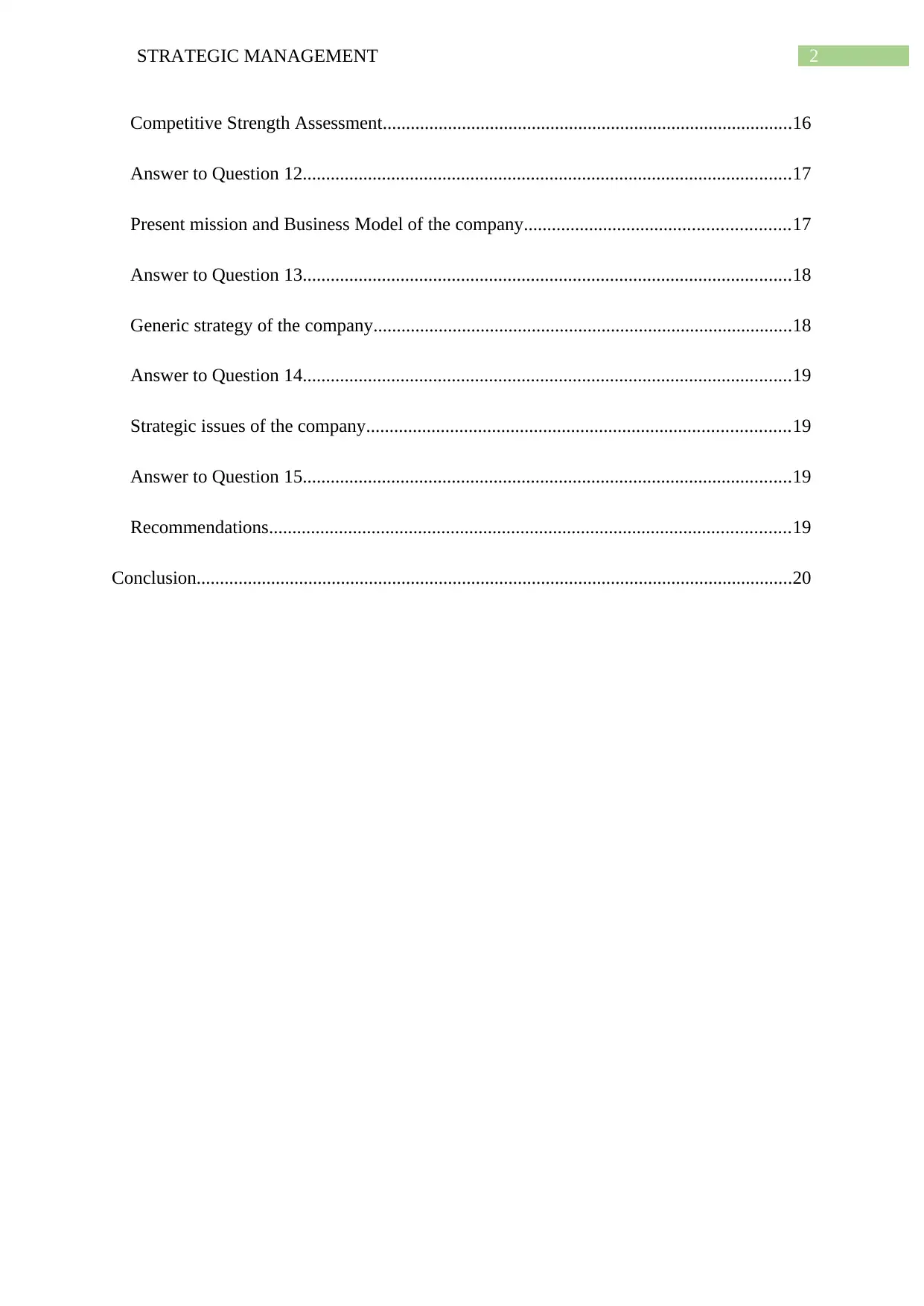
2STRATEGIC MANAGEMENT
Competitive Strength Assessment........................................................................................16
Answer to Question 12.........................................................................................................17
Present mission and Business Model of the company.........................................................17
Answer to Question 13.........................................................................................................18
Generic strategy of the company..........................................................................................18
Answer to Question 14.........................................................................................................19
Strategic issues of the company...........................................................................................19
Answer to Question 15.........................................................................................................19
Recommendations................................................................................................................19
Conclusion................................................................................................................................20
Competitive Strength Assessment........................................................................................16
Answer to Question 12.........................................................................................................17
Present mission and Business Model of the company.........................................................17
Answer to Question 13.........................................................................................................18
Generic strategy of the company..........................................................................................18
Answer to Question 14.........................................................................................................19
Strategic issues of the company...........................................................................................19
Answer to Question 15.........................................................................................................19
Recommendations................................................................................................................19
Conclusion................................................................................................................................20
⊘ This is a preview!⊘
Do you want full access?
Subscribe today to unlock all pages.

Trusted by 1+ million students worldwide
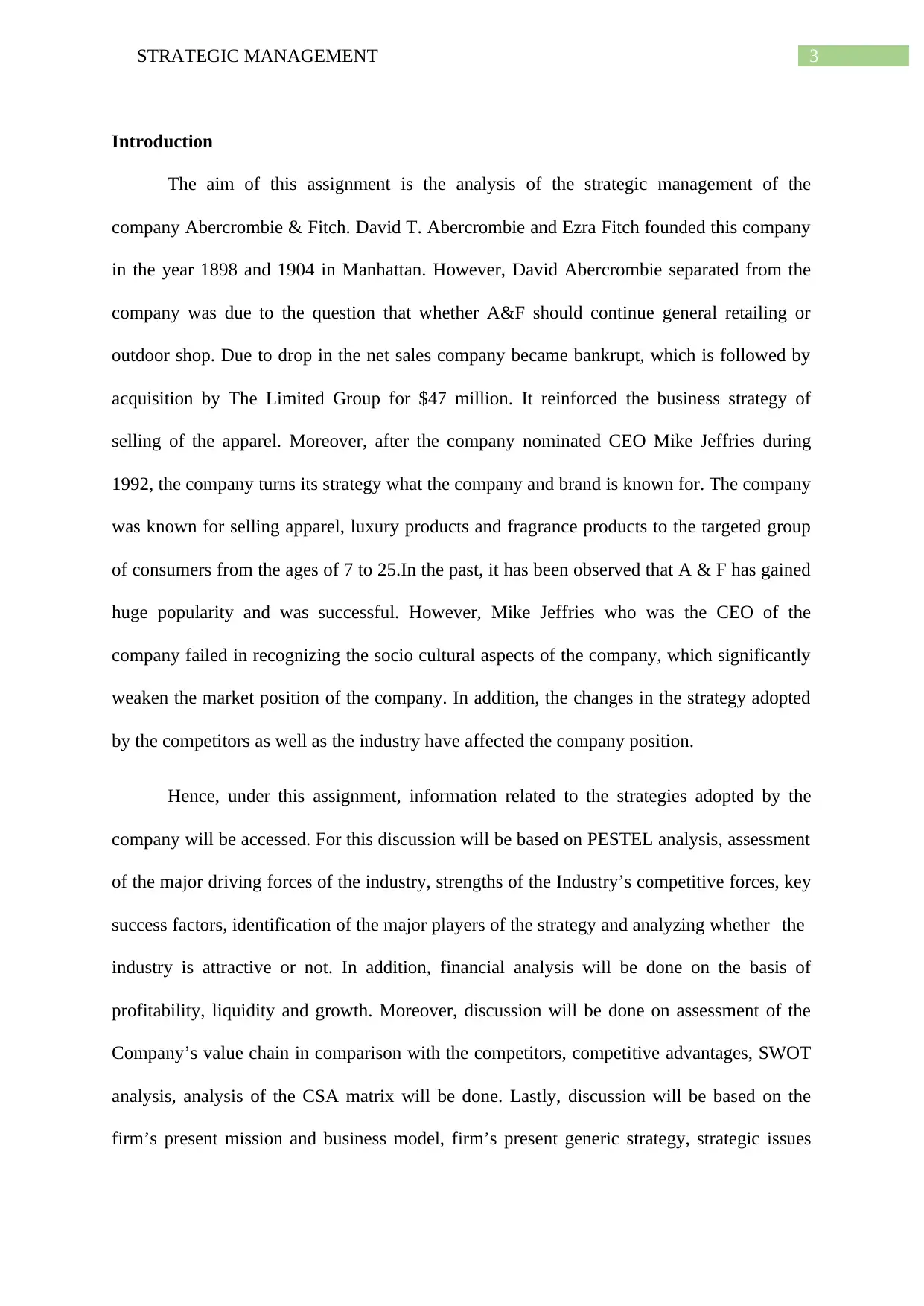
3STRATEGIC MANAGEMENT
Introduction
The aim of this assignment is the analysis of the strategic management of the
company Abercrombie & Fitch. David T. Abercrombie and Ezra Fitch founded this company
in the year 1898 and 1904 in Manhattan. However, David Abercrombie separated from the
company was due to the question that whether A&F should continue general retailing or
outdoor shop. Due to drop in the net sales company became bankrupt, which is followed by
acquisition by The Limited Group for $47 million. It reinforced the business strategy of
selling of the apparel. Moreover, after the company nominated CEO Mike Jeffries during
1992, the company turns its strategy what the company and brand is known for. The company
was known for selling apparel, luxury products and fragrance products to the targeted group
of consumers from the ages of 7 to 25.In the past, it has been observed that A & F has gained
huge popularity and was successful. However, Mike Jeffries who was the CEO of the
company failed in recognizing the socio cultural aspects of the company, which significantly
weaken the market position of the company. In addition, the changes in the strategy adopted
by the competitors as well as the industry have affected the company position.
Hence, under this assignment, information related to the strategies adopted by the
company will be accessed. For this discussion will be based on PESTEL analysis, assessment
of the major driving forces of the industry, strengths of the Industry’s competitive forces, key
success factors, identification of the major players of the strategy and analyzing whether the
industry is attractive or not. In addition, financial analysis will be done on the basis of
profitability, liquidity and growth. Moreover, discussion will be done on assessment of the
Company’s value chain in comparison with the competitors, competitive advantages, SWOT
analysis, analysis of the CSA matrix will be done. Lastly, discussion will be based on the
firm’s present mission and business model, firm’s present generic strategy, strategic issues
Introduction
The aim of this assignment is the analysis of the strategic management of the
company Abercrombie & Fitch. David T. Abercrombie and Ezra Fitch founded this company
in the year 1898 and 1904 in Manhattan. However, David Abercrombie separated from the
company was due to the question that whether A&F should continue general retailing or
outdoor shop. Due to drop in the net sales company became bankrupt, which is followed by
acquisition by The Limited Group for $47 million. It reinforced the business strategy of
selling of the apparel. Moreover, after the company nominated CEO Mike Jeffries during
1992, the company turns its strategy what the company and brand is known for. The company
was known for selling apparel, luxury products and fragrance products to the targeted group
of consumers from the ages of 7 to 25.In the past, it has been observed that A & F has gained
huge popularity and was successful. However, Mike Jeffries who was the CEO of the
company failed in recognizing the socio cultural aspects of the company, which significantly
weaken the market position of the company. In addition, the changes in the strategy adopted
by the competitors as well as the industry have affected the company position.
Hence, under this assignment, information related to the strategies adopted by the
company will be accessed. For this discussion will be based on PESTEL analysis, assessment
of the major driving forces of the industry, strengths of the Industry’s competitive forces, key
success factors, identification of the major players of the strategy and analyzing whether the
industry is attractive or not. In addition, financial analysis will be done on the basis of
profitability, liquidity and growth. Moreover, discussion will be done on assessment of the
Company’s value chain in comparison with the competitors, competitive advantages, SWOT
analysis, analysis of the CSA matrix will be done. Lastly, discussion will be based on the
firm’s present mission and business model, firm’s present generic strategy, strategic issues
Paraphrase This Document
Need a fresh take? Get an instant paraphrase of this document with our AI Paraphraser
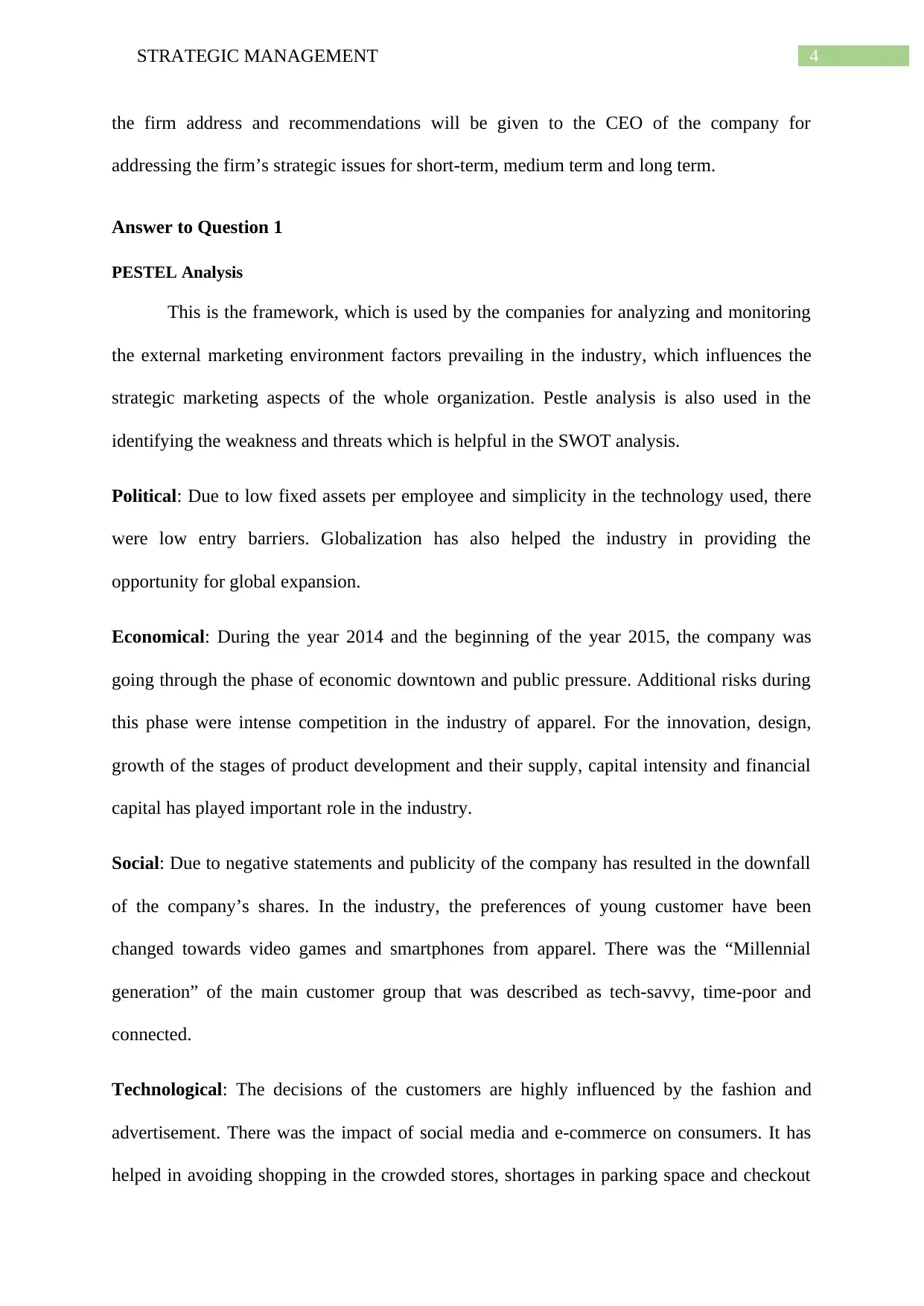
4STRATEGIC MANAGEMENT
the firm address and recommendations will be given to the CEO of the company for
addressing the firm’s strategic issues for short-term, medium term and long term.
Answer to Question 1
PESTEL Analysis
This is the framework, which is used by the companies for analyzing and monitoring
the external marketing environment factors prevailing in the industry, which influences the
strategic marketing aspects of the whole organization. Pestle analysis is also used in the
identifying the weakness and threats which is helpful in the SWOT analysis.
Political: Due to low fixed assets per employee and simplicity in the technology used, there
were low entry barriers. Globalization has also helped the industry in providing the
opportunity for global expansion.
Economical: During the year 2014 and the beginning of the year 2015, the company was
going through the phase of economic downtown and public pressure. Additional risks during
this phase were intense competition in the industry of apparel. For the innovation, design,
growth of the stages of product development and their supply, capital intensity and financial
capital has played important role in the industry.
Social: Due to negative statements and publicity of the company has resulted in the downfall
of the company’s shares. In the industry, the preferences of young customer have been
changed towards video games and smartphones from apparel. There was the “Millennial
generation” of the main customer group that was described as tech-savvy, time-poor and
connected.
Technological: The decisions of the customers are highly influenced by the fashion and
advertisement. There was the impact of social media and e-commerce on consumers. It has
helped in avoiding shopping in the crowded stores, shortages in parking space and checkout
the firm address and recommendations will be given to the CEO of the company for
addressing the firm’s strategic issues for short-term, medium term and long term.
Answer to Question 1
PESTEL Analysis
This is the framework, which is used by the companies for analyzing and monitoring
the external marketing environment factors prevailing in the industry, which influences the
strategic marketing aspects of the whole organization. Pestle analysis is also used in the
identifying the weakness and threats which is helpful in the SWOT analysis.
Political: Due to low fixed assets per employee and simplicity in the technology used, there
were low entry barriers. Globalization has also helped the industry in providing the
opportunity for global expansion.
Economical: During the year 2014 and the beginning of the year 2015, the company was
going through the phase of economic downtown and public pressure. Additional risks during
this phase were intense competition in the industry of apparel. For the innovation, design,
growth of the stages of product development and their supply, capital intensity and financial
capital has played important role in the industry.
Social: Due to negative statements and publicity of the company has resulted in the downfall
of the company’s shares. In the industry, the preferences of young customer have been
changed towards video games and smartphones from apparel. There was the “Millennial
generation” of the main customer group that was described as tech-savvy, time-poor and
connected.
Technological: The decisions of the customers are highly influenced by the fashion and
advertisement. There was the impact of social media and e-commerce on consumers. It has
helped in avoiding shopping in the crowded stores, shortages in parking space and checkout
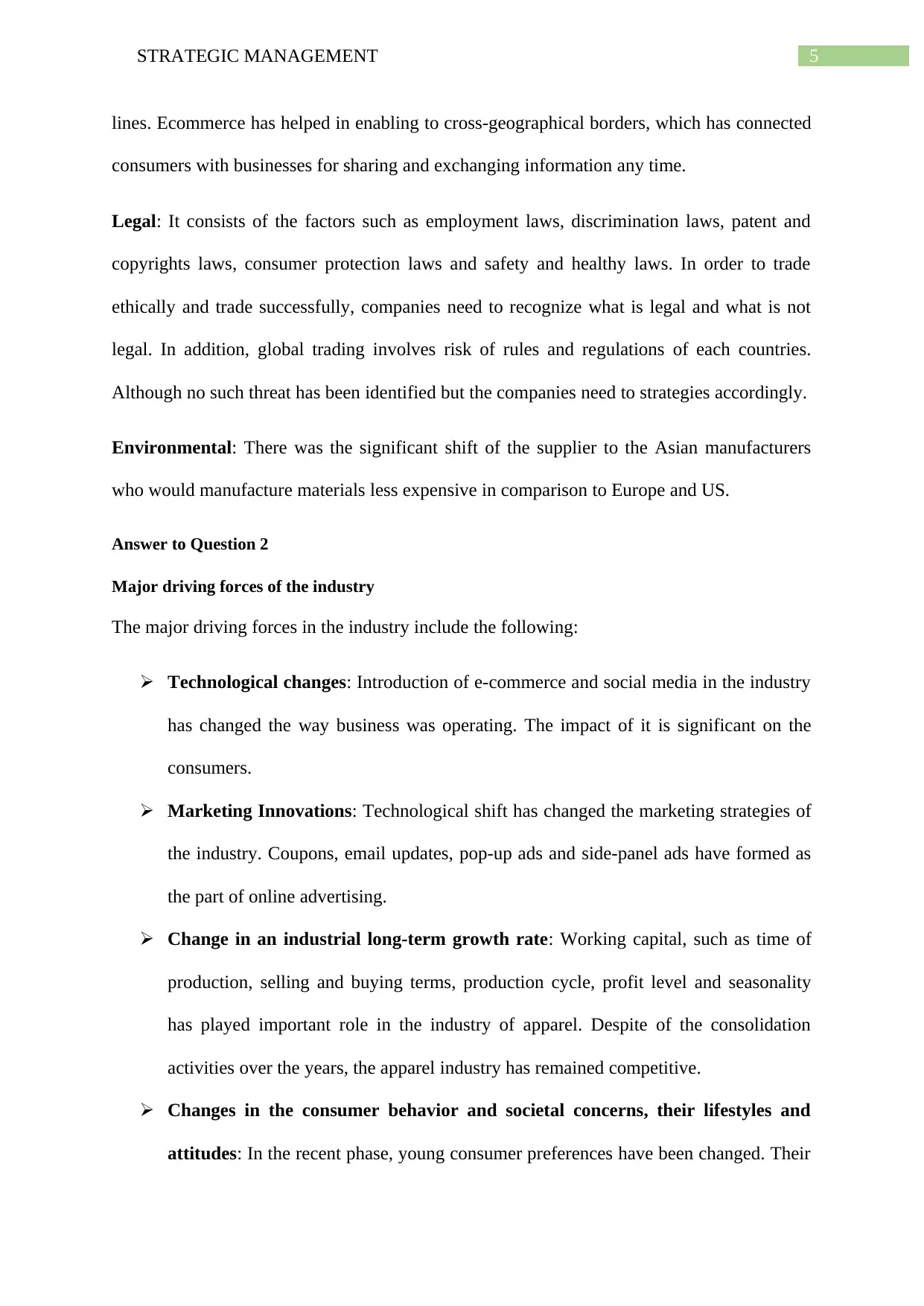
5STRATEGIC MANAGEMENT
lines. Ecommerce has helped in enabling to cross-geographical borders, which has connected
consumers with businesses for sharing and exchanging information any time.
Legal: It consists of the factors such as employment laws, discrimination laws, patent and
copyrights laws, consumer protection laws and safety and healthy laws. In order to trade
ethically and trade successfully, companies need to recognize what is legal and what is not
legal. In addition, global trading involves risk of rules and regulations of each countries.
Although no such threat has been identified but the companies need to strategies accordingly.
Environmental: There was the significant shift of the supplier to the Asian manufacturers
who would manufacture materials less expensive in comparison to Europe and US.
Answer to Question 2
Major driving forces of the industry
The major driving forces in the industry include the following:
Technological changes: Introduction of e-commerce and social media in the industry
has changed the way business was operating. The impact of it is significant on the
consumers.
Marketing Innovations: Technological shift has changed the marketing strategies of
the industry. Coupons, email updates, pop-up ads and side-panel ads have formed as
the part of online advertising.
Change in an industrial long-term growth rate: Working capital, such as time of
production, selling and buying terms, production cycle, profit level and seasonality
has played important role in the industry of apparel. Despite of the consolidation
activities over the years, the apparel industry has remained competitive.
Changes in the consumer behavior and societal concerns, their lifestyles and
attitudes: In the recent phase, young consumer preferences have been changed. Their
lines. Ecommerce has helped in enabling to cross-geographical borders, which has connected
consumers with businesses for sharing and exchanging information any time.
Legal: It consists of the factors such as employment laws, discrimination laws, patent and
copyrights laws, consumer protection laws and safety and healthy laws. In order to trade
ethically and trade successfully, companies need to recognize what is legal and what is not
legal. In addition, global trading involves risk of rules and regulations of each countries.
Although no such threat has been identified but the companies need to strategies accordingly.
Environmental: There was the significant shift of the supplier to the Asian manufacturers
who would manufacture materials less expensive in comparison to Europe and US.
Answer to Question 2
Major driving forces of the industry
The major driving forces in the industry include the following:
Technological changes: Introduction of e-commerce and social media in the industry
has changed the way business was operating. The impact of it is significant on the
consumers.
Marketing Innovations: Technological shift has changed the marketing strategies of
the industry. Coupons, email updates, pop-up ads and side-panel ads have formed as
the part of online advertising.
Change in an industrial long-term growth rate: Working capital, such as time of
production, selling and buying terms, production cycle, profit level and seasonality
has played important role in the industry of apparel. Despite of the consolidation
activities over the years, the apparel industry has remained competitive.
Changes in the consumer behavior and societal concerns, their lifestyles and
attitudes: In the recent phase, young consumer preferences have been changed. Their
⊘ This is a preview!⊘
Do you want full access?
Subscribe today to unlock all pages.

Trusted by 1+ million students worldwide
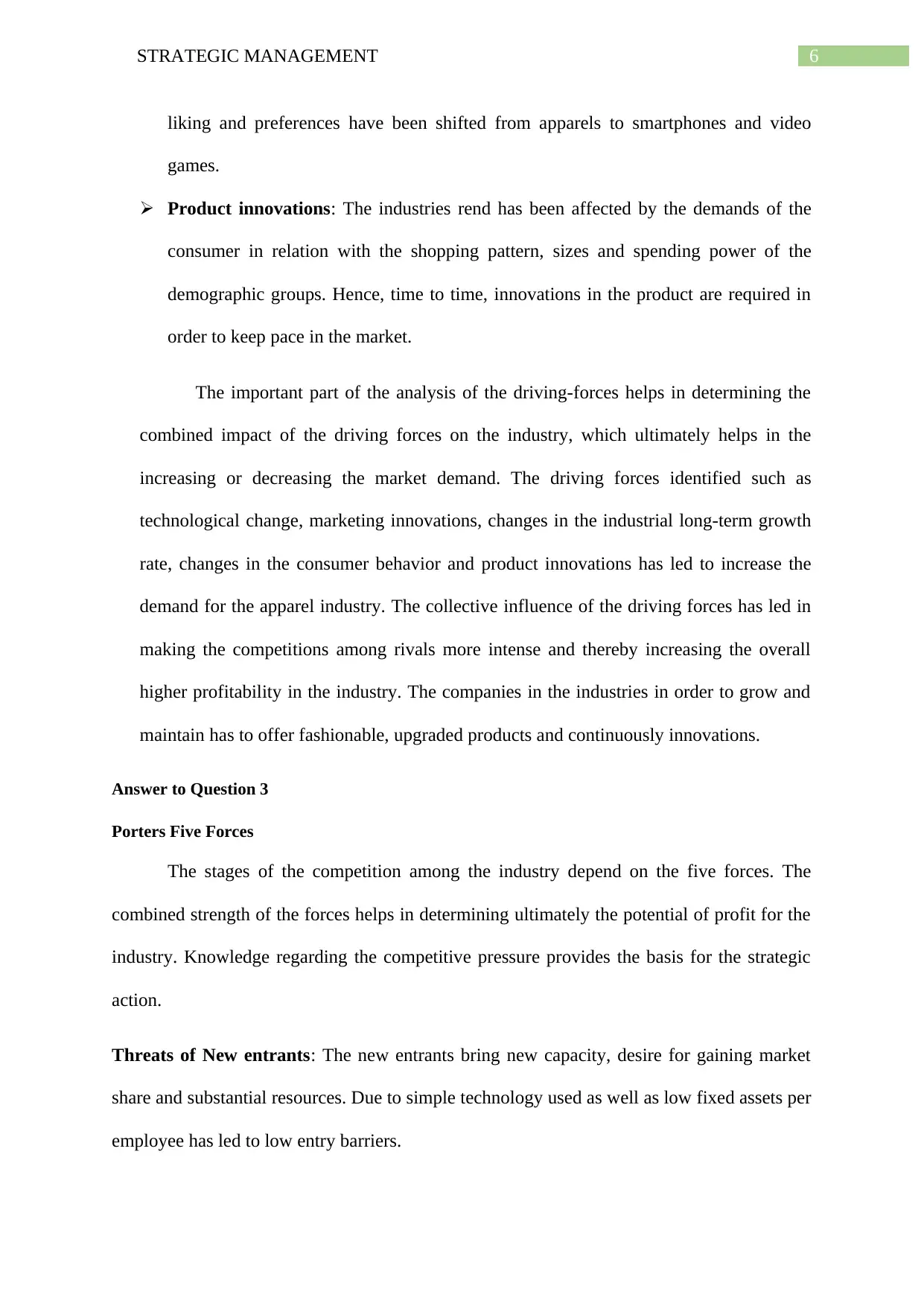
6STRATEGIC MANAGEMENT
liking and preferences have been shifted from apparels to smartphones and video
games.
Product innovations: The industries rend has been affected by the demands of the
consumer in relation with the shopping pattern, sizes and spending power of the
demographic groups. Hence, time to time, innovations in the product are required in
order to keep pace in the market.
The important part of the analysis of the driving-forces helps in determining the
combined impact of the driving forces on the industry, which ultimately helps in the
increasing or decreasing the market demand. The driving forces identified such as
technological change, marketing innovations, changes in the industrial long-term growth
rate, changes in the consumer behavior and product innovations has led to increase the
demand for the apparel industry. The collective influence of the driving forces has led in
making the competitions among rivals more intense and thereby increasing the overall
higher profitability in the industry. The companies in the industries in order to grow and
maintain has to offer fashionable, upgraded products and continuously innovations.
Answer to Question 3
Porters Five Forces
The stages of the competition among the industry depend on the five forces. The
combined strength of the forces helps in determining ultimately the potential of profit for the
industry. Knowledge regarding the competitive pressure provides the basis for the strategic
action.
Threats of New entrants: The new entrants bring new capacity, desire for gaining market
share and substantial resources. Due to simple technology used as well as low fixed assets per
employee has led to low entry barriers.
liking and preferences have been shifted from apparels to smartphones and video
games.
Product innovations: The industries rend has been affected by the demands of the
consumer in relation with the shopping pattern, sizes and spending power of the
demographic groups. Hence, time to time, innovations in the product are required in
order to keep pace in the market.
The important part of the analysis of the driving-forces helps in determining the
combined impact of the driving forces on the industry, which ultimately helps in the
increasing or decreasing the market demand. The driving forces identified such as
technological change, marketing innovations, changes in the industrial long-term growth
rate, changes in the consumer behavior and product innovations has led to increase the
demand for the apparel industry. The collective influence of the driving forces has led in
making the competitions among rivals more intense and thereby increasing the overall
higher profitability in the industry. The companies in the industries in order to grow and
maintain has to offer fashionable, upgraded products and continuously innovations.
Answer to Question 3
Porters Five Forces
The stages of the competition among the industry depend on the five forces. The
combined strength of the forces helps in determining ultimately the potential of profit for the
industry. Knowledge regarding the competitive pressure provides the basis for the strategic
action.
Threats of New entrants: The new entrants bring new capacity, desire for gaining market
share and substantial resources. Due to simple technology used as well as low fixed assets per
employee has led to low entry barriers.
Paraphrase This Document
Need a fresh take? Get an instant paraphrase of this document with our AI Paraphraser
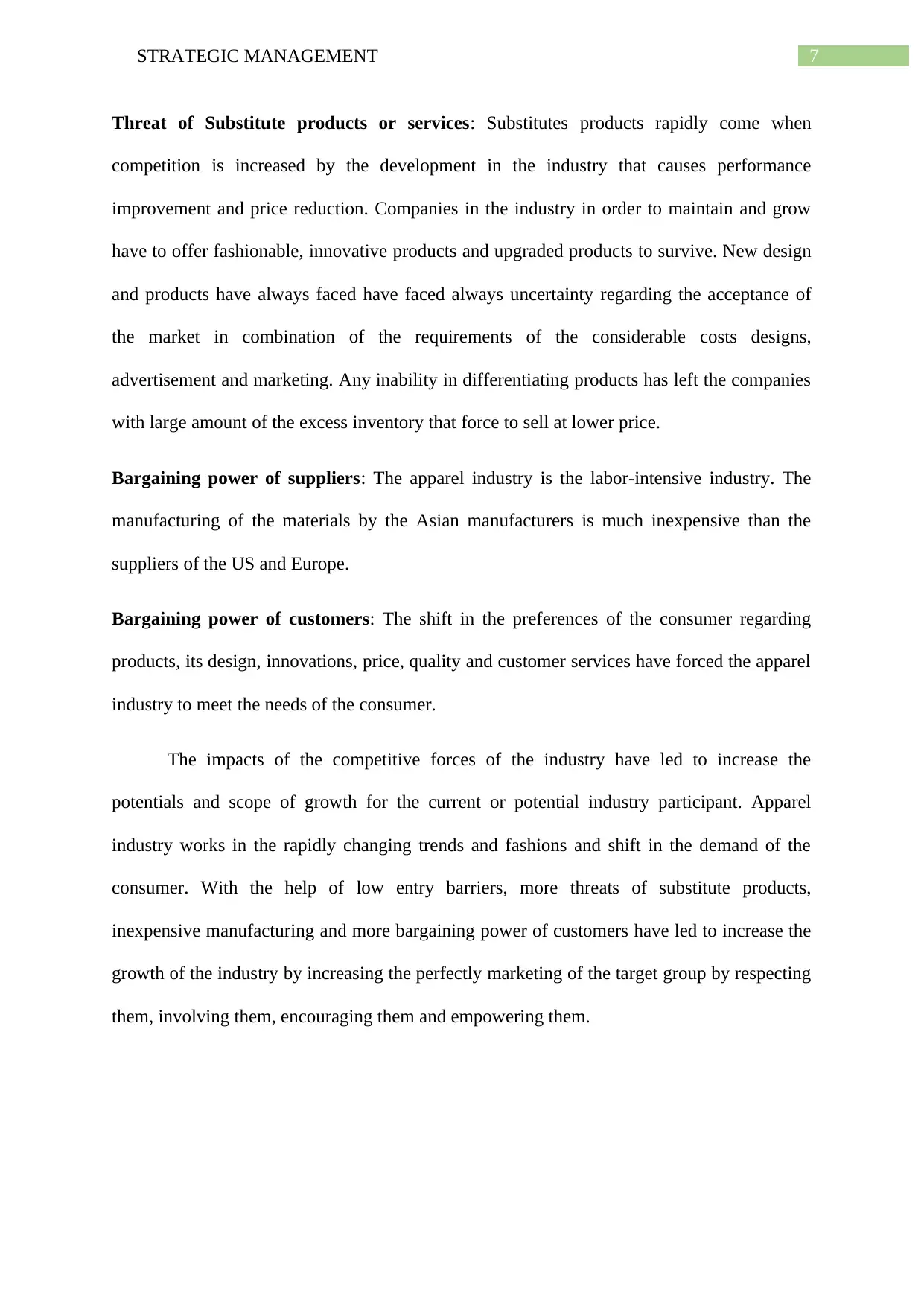
7STRATEGIC MANAGEMENT
Threat of Substitute products or services: Substitutes products rapidly come when
competition is increased by the development in the industry that causes performance
improvement and price reduction. Companies in the industry in order to maintain and grow
have to offer fashionable, innovative products and upgraded products to survive. New design
and products have always faced have faced always uncertainty regarding the acceptance of
the market in combination of the requirements of the considerable costs designs,
advertisement and marketing. Any inability in differentiating products has left the companies
with large amount of the excess inventory that force to sell at lower price.
Bargaining power of suppliers: The apparel industry is the labor-intensive industry. The
manufacturing of the materials by the Asian manufacturers is much inexpensive than the
suppliers of the US and Europe.
Bargaining power of customers: The shift in the preferences of the consumer regarding
products, its design, innovations, price, quality and customer services have forced the apparel
industry to meet the needs of the consumer.
The impacts of the competitive forces of the industry have led to increase the
potentials and scope of growth for the current or potential industry participant. Apparel
industry works in the rapidly changing trends and fashions and shift in the demand of the
consumer. With the help of low entry barriers, more threats of substitute products,
inexpensive manufacturing and more bargaining power of customers have led to increase the
growth of the industry by increasing the perfectly marketing of the target group by respecting
them, involving them, encouraging them and empowering them.
Threat of Substitute products or services: Substitutes products rapidly come when
competition is increased by the development in the industry that causes performance
improvement and price reduction. Companies in the industry in order to maintain and grow
have to offer fashionable, innovative products and upgraded products to survive. New design
and products have always faced have faced always uncertainty regarding the acceptance of
the market in combination of the requirements of the considerable costs designs,
advertisement and marketing. Any inability in differentiating products has left the companies
with large amount of the excess inventory that force to sell at lower price.
Bargaining power of suppliers: The apparel industry is the labor-intensive industry. The
manufacturing of the materials by the Asian manufacturers is much inexpensive than the
suppliers of the US and Europe.
Bargaining power of customers: The shift in the preferences of the consumer regarding
products, its design, innovations, price, quality and customer services have forced the apparel
industry to meet the needs of the consumer.
The impacts of the competitive forces of the industry have led to increase the
potentials and scope of growth for the current or potential industry participant. Apparel
industry works in the rapidly changing trends and fashions and shift in the demand of the
consumer. With the help of low entry barriers, more threats of substitute products,
inexpensive manufacturing and more bargaining power of customers have led to increase the
growth of the industry by increasing the perfectly marketing of the target group by respecting
them, involving them, encouraging them and empowering them.
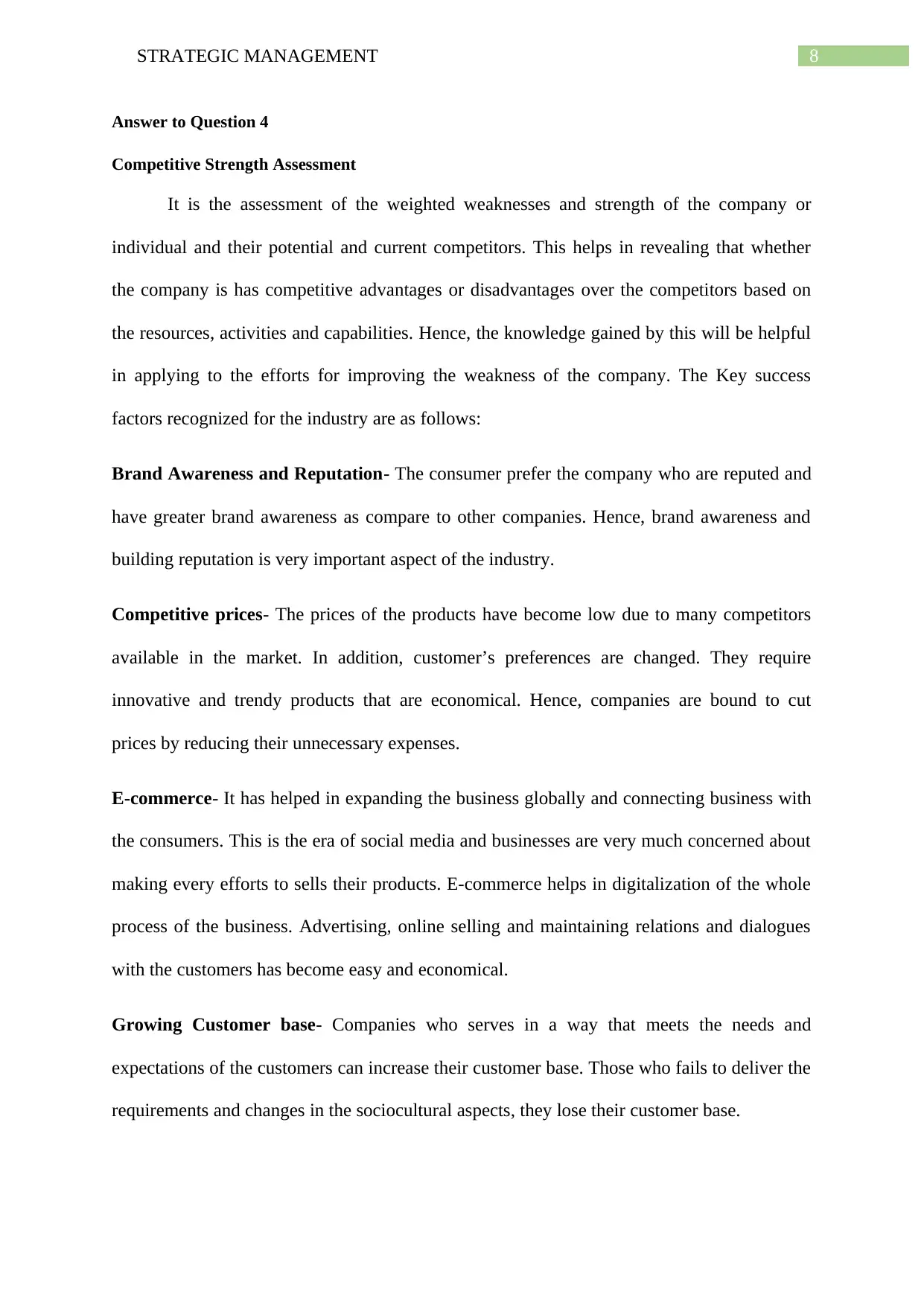
8STRATEGIC MANAGEMENT
Answer to Question 4
Competitive Strength Assessment
It is the assessment of the weighted weaknesses and strength of the company or
individual and their potential and current competitors. This helps in revealing that whether
the company is has competitive advantages or disadvantages over the competitors based on
the resources, activities and capabilities. Hence, the knowledge gained by this will be helpful
in applying to the efforts for improving the weakness of the company. The Key success
factors recognized for the industry are as follows:
Brand Awareness and Reputation- The consumer prefer the company who are reputed and
have greater brand awareness as compare to other companies. Hence, brand awareness and
building reputation is very important aspect of the industry.
Competitive prices- The prices of the products have become low due to many competitors
available in the market. In addition, customer’s preferences are changed. They require
innovative and trendy products that are economical. Hence, companies are bound to cut
prices by reducing their unnecessary expenses.
E-commerce- It has helped in expanding the business globally and connecting business with
the consumers. This is the era of social media and businesses are very much concerned about
making every efforts to sells their products. E-commerce helps in digitalization of the whole
process of the business. Advertising, online selling and maintaining relations and dialogues
with the customers has become easy and economical.
Growing Customer base- Companies who serves in a way that meets the needs and
expectations of the customers can increase their customer base. Those who fails to deliver the
requirements and changes in the sociocultural aspects, they lose their customer base.
Answer to Question 4
Competitive Strength Assessment
It is the assessment of the weighted weaknesses and strength of the company or
individual and their potential and current competitors. This helps in revealing that whether
the company is has competitive advantages or disadvantages over the competitors based on
the resources, activities and capabilities. Hence, the knowledge gained by this will be helpful
in applying to the efforts for improving the weakness of the company. The Key success
factors recognized for the industry are as follows:
Brand Awareness and Reputation- The consumer prefer the company who are reputed and
have greater brand awareness as compare to other companies. Hence, brand awareness and
building reputation is very important aspect of the industry.
Competitive prices- The prices of the products have become low due to many competitors
available in the market. In addition, customer’s preferences are changed. They require
innovative and trendy products that are economical. Hence, companies are bound to cut
prices by reducing their unnecessary expenses.
E-commerce- It has helped in expanding the business globally and connecting business with
the consumers. This is the era of social media and businesses are very much concerned about
making every efforts to sells their products. E-commerce helps in digitalization of the whole
process of the business. Advertising, online selling and maintaining relations and dialogues
with the customers has become easy and economical.
Growing Customer base- Companies who serves in a way that meets the needs and
expectations of the customers can increase their customer base. Those who fails to deliver the
requirements and changes in the sociocultural aspects, they lose their customer base.
⊘ This is a preview!⊘
Do you want full access?
Subscribe today to unlock all pages.

Trusted by 1+ million students worldwide
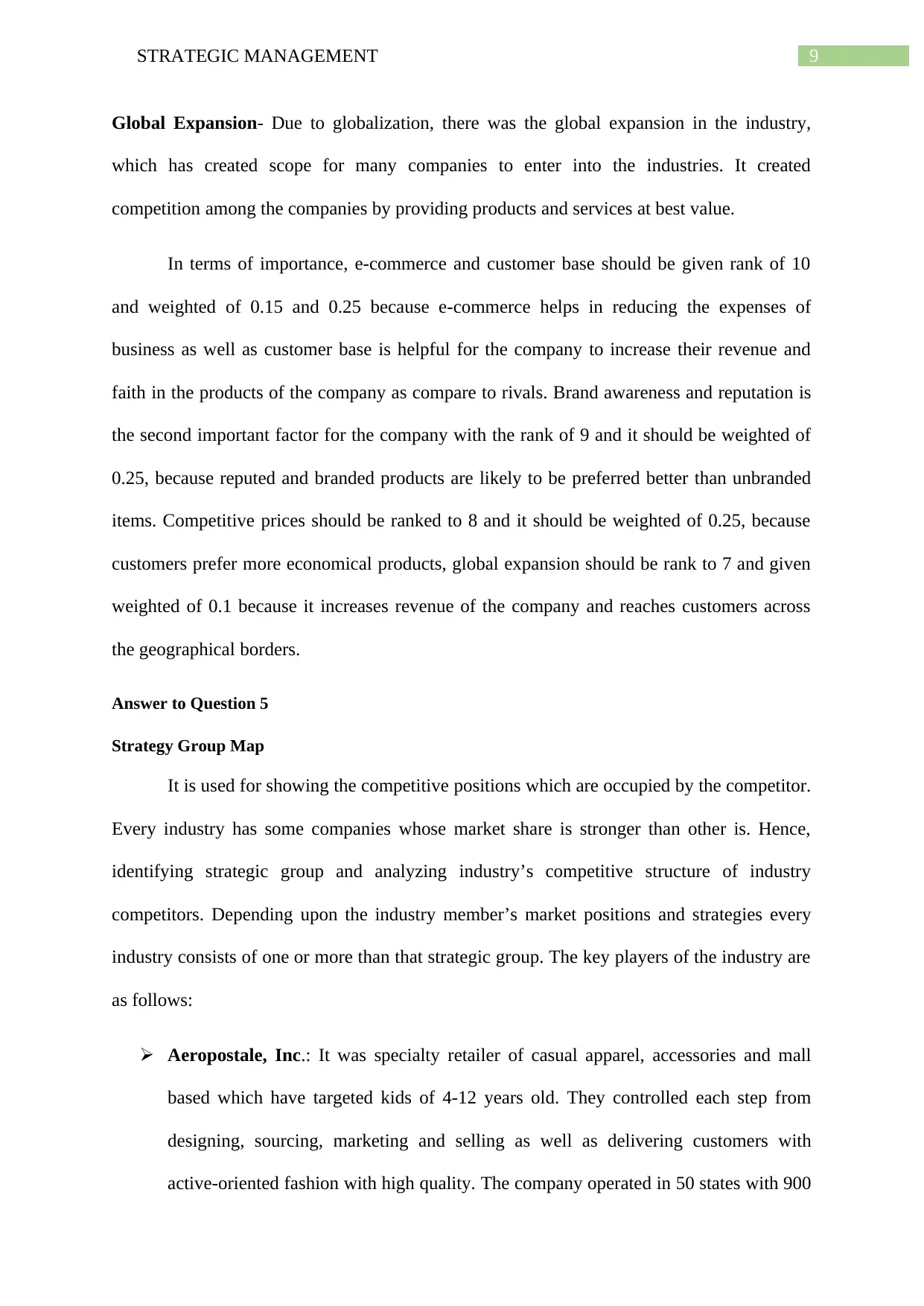
9STRATEGIC MANAGEMENT
Global Expansion- Due to globalization, there was the global expansion in the industry,
which has created scope for many companies to enter into the industries. It created
competition among the companies by providing products and services at best value.
In terms of importance, e-commerce and customer base should be given rank of 10
and weighted of 0.15 and 0.25 because e-commerce helps in reducing the expenses of
business as well as customer base is helpful for the company to increase their revenue and
faith in the products of the company as compare to rivals. Brand awareness and reputation is
the second important factor for the company with the rank of 9 and it should be weighted of
0.25, because reputed and branded products are likely to be preferred better than unbranded
items. Competitive prices should be ranked to 8 and it should be weighted of 0.25, because
customers prefer more economical products, global expansion should be rank to 7 and given
weighted of 0.1 because it increases revenue of the company and reaches customers across
the geographical borders.
Answer to Question 5
Strategy Group Map
It is used for showing the competitive positions which are occupied by the competitor.
Every industry has some companies whose market share is stronger than other is. Hence,
identifying strategic group and analyzing industry’s competitive structure of industry
competitors. Depending upon the industry member’s market positions and strategies every
industry consists of one or more than that strategic group. The key players of the industry are
as follows:
Aeropostale, Inc.: It was specialty retailer of casual apparel, accessories and mall
based which have targeted kids of 4-12 years old. They controlled each step from
designing, sourcing, marketing and selling as well as delivering customers with
active-oriented fashion with high quality. The company operated in 50 states with 900
Global Expansion- Due to globalization, there was the global expansion in the industry,
which has created scope for many companies to enter into the industries. It created
competition among the companies by providing products and services at best value.
In terms of importance, e-commerce and customer base should be given rank of 10
and weighted of 0.15 and 0.25 because e-commerce helps in reducing the expenses of
business as well as customer base is helpful for the company to increase their revenue and
faith in the products of the company as compare to rivals. Brand awareness and reputation is
the second important factor for the company with the rank of 9 and it should be weighted of
0.25, because reputed and branded products are likely to be preferred better than unbranded
items. Competitive prices should be ranked to 8 and it should be weighted of 0.25, because
customers prefer more economical products, global expansion should be rank to 7 and given
weighted of 0.1 because it increases revenue of the company and reaches customers across
the geographical borders.
Answer to Question 5
Strategy Group Map
It is used for showing the competitive positions which are occupied by the competitor.
Every industry has some companies whose market share is stronger than other is. Hence,
identifying strategic group and analyzing industry’s competitive structure of industry
competitors. Depending upon the industry member’s market positions and strategies every
industry consists of one or more than that strategic group. The key players of the industry are
as follows:
Aeropostale, Inc.: It was specialty retailer of casual apparel, accessories and mall
based which have targeted kids of 4-12 years old. They controlled each step from
designing, sourcing, marketing and selling as well as delivering customers with
active-oriented fashion with high quality. The company operated in 50 states with 900
Paraphrase This Document
Need a fresh take? Get an instant paraphrase of this document with our AI Paraphraser
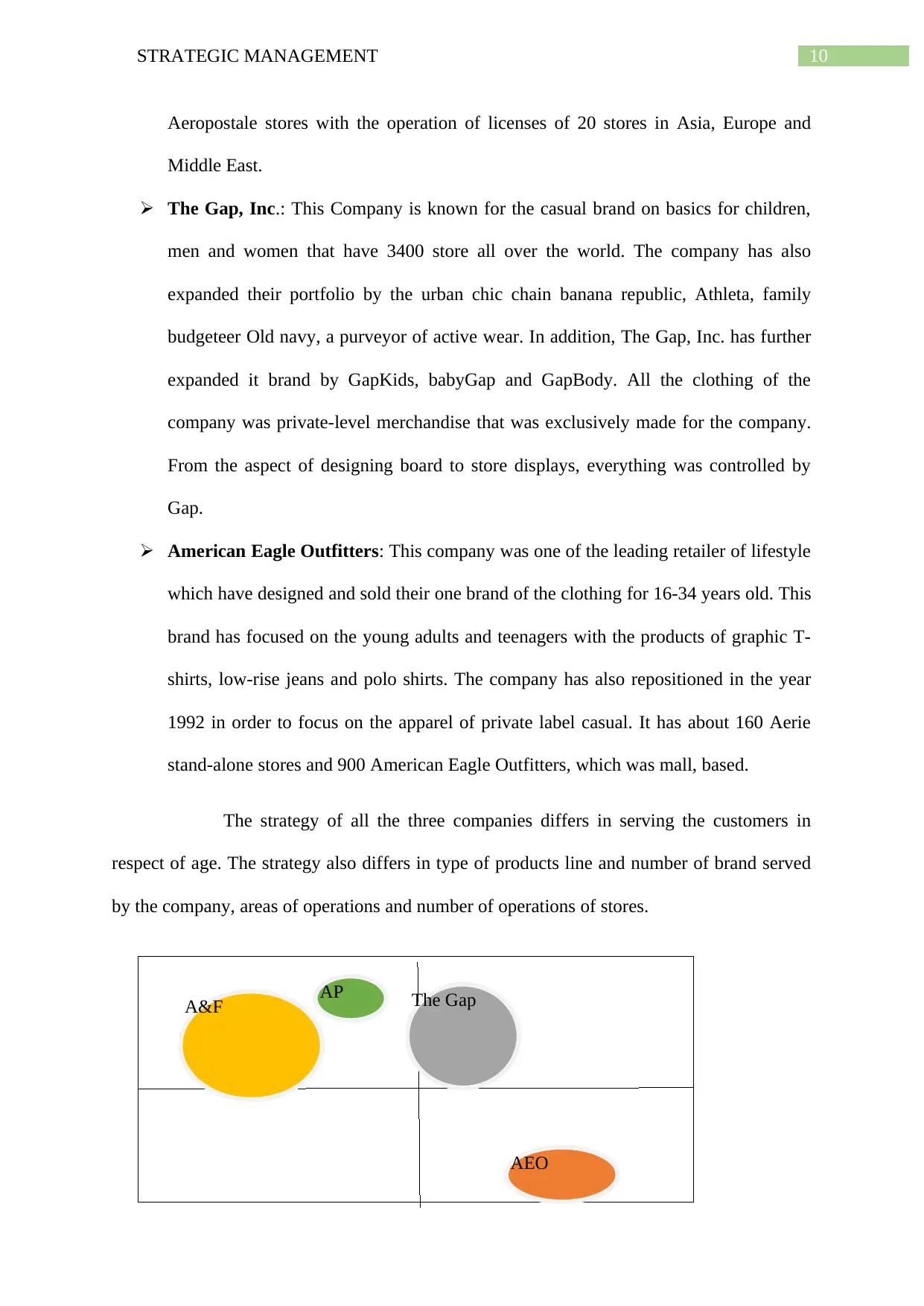
10STRATEGIC MANAGEMENT
Aeropostale stores with the operation of licenses of 20 stores in Asia, Europe and
Middle East.
The Gap, Inc.: This Company is known for the casual brand on basics for children,
men and women that have 3400 store all over the world. The company has also
expanded their portfolio by the urban chic chain banana republic, Athleta, family
budgeteer Old navy, a purveyor of active wear. In addition, The Gap, Inc. has further
expanded it brand by GapKids, babyGap and GapBody. All the clothing of the
company was private-level merchandise that was exclusively made for the company.
From the aspect of designing board to store displays, everything was controlled by
Gap.
American Eagle Outfitters: This company was one of the leading retailer of lifestyle
which have designed and sold their one brand of the clothing for 16-34 years old. This
brand has focused on the young adults and teenagers with the products of graphic T-
shirts, low-rise jeans and polo shirts. The company has also repositioned in the year
1992 in order to focus on the apparel of private label casual. It has about 160 Aerie
stand-alone stores and 900 American Eagle Outfitters, which was mall, based.
The strategy of all the three companies differs in serving the customers in
respect of age. The strategy also differs in type of products line and number of brand served
by the company, areas of operations and number of operations of stores.
A&F The Gap
AEO
AP
Aeropostale stores with the operation of licenses of 20 stores in Asia, Europe and
Middle East.
The Gap, Inc.: This Company is known for the casual brand on basics for children,
men and women that have 3400 store all over the world. The company has also
expanded their portfolio by the urban chic chain banana republic, Athleta, family
budgeteer Old navy, a purveyor of active wear. In addition, The Gap, Inc. has further
expanded it brand by GapKids, babyGap and GapBody. All the clothing of the
company was private-level merchandise that was exclusively made for the company.
From the aspect of designing board to store displays, everything was controlled by
Gap.
American Eagle Outfitters: This company was one of the leading retailer of lifestyle
which have designed and sold their one brand of the clothing for 16-34 years old. This
brand has focused on the young adults and teenagers with the products of graphic T-
shirts, low-rise jeans and polo shirts. The company has also repositioned in the year
1992 in order to focus on the apparel of private label casual. It has about 160 Aerie
stand-alone stores and 900 American Eagle Outfitters, which was mall, based.
The strategy of all the three companies differs in serving the customers in
respect of age. The strategy also differs in type of products line and number of brand served
by the company, areas of operations and number of operations of stores.
A&F The Gap
AEO
AP
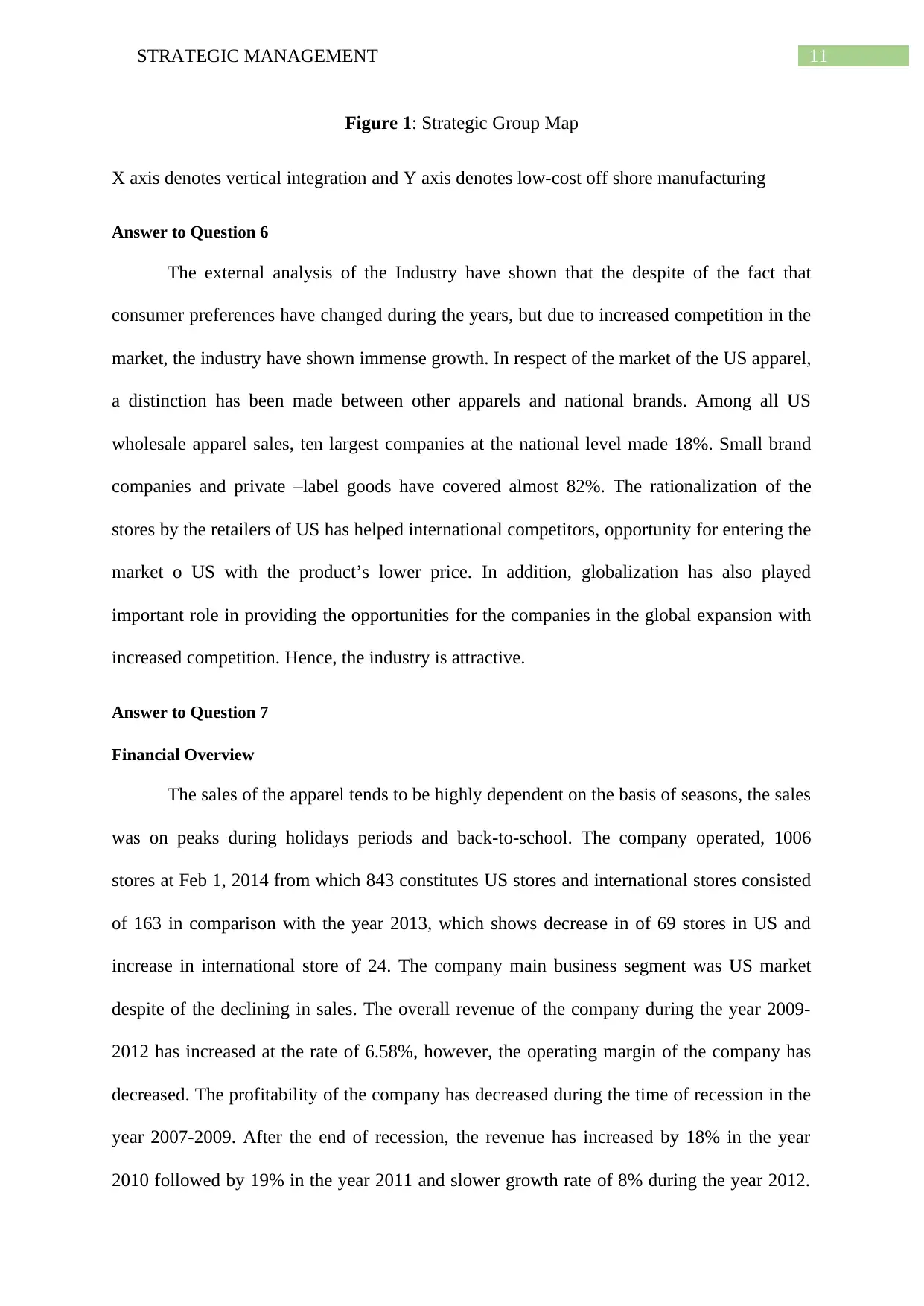
11STRATEGIC MANAGEMENT
Figure 1: Strategic Group Map
X axis denotes vertical integration and Y axis denotes low-cost off shore manufacturing
Answer to Question 6
The external analysis of the Industry have shown that the despite of the fact that
consumer preferences have changed during the years, but due to increased competition in the
market, the industry have shown immense growth. In respect of the market of the US apparel,
a distinction has been made between other apparels and national brands. Among all US
wholesale apparel sales, ten largest companies at the national level made 18%. Small brand
companies and private –label goods have covered almost 82%. The rationalization of the
stores by the retailers of US has helped international competitors, opportunity for entering the
market o US with the product’s lower price. In addition, globalization has also played
important role in providing the opportunities for the companies in the global expansion with
increased competition. Hence, the industry is attractive.
Answer to Question 7
Financial Overview
The sales of the apparel tends to be highly dependent on the basis of seasons, the sales
was on peaks during holidays periods and back-to-school. The company operated, 1006
stores at Feb 1, 2014 from which 843 constitutes US stores and international stores consisted
of 163 in comparison with the year 2013, which shows decrease in of 69 stores in US and
increase in international store of 24. The company main business segment was US market
despite of the declining in sales. The overall revenue of the company during the year 2009-
2012 has increased at the rate of 6.58%, however, the operating margin of the company has
decreased. The profitability of the company has decreased during the time of recession in the
year 2007-2009. After the end of recession, the revenue has increased by 18% in the year
2010 followed by 19% in the year 2011 and slower growth rate of 8% during the year 2012.
Figure 1: Strategic Group Map
X axis denotes vertical integration and Y axis denotes low-cost off shore manufacturing
Answer to Question 6
The external analysis of the Industry have shown that the despite of the fact that
consumer preferences have changed during the years, but due to increased competition in the
market, the industry have shown immense growth. In respect of the market of the US apparel,
a distinction has been made between other apparels and national brands. Among all US
wholesale apparel sales, ten largest companies at the national level made 18%. Small brand
companies and private –label goods have covered almost 82%. The rationalization of the
stores by the retailers of US has helped international competitors, opportunity for entering the
market o US with the product’s lower price. In addition, globalization has also played
important role in providing the opportunities for the companies in the global expansion with
increased competition. Hence, the industry is attractive.
Answer to Question 7
Financial Overview
The sales of the apparel tends to be highly dependent on the basis of seasons, the sales
was on peaks during holidays periods and back-to-school. The company operated, 1006
stores at Feb 1, 2014 from which 843 constitutes US stores and international stores consisted
of 163 in comparison with the year 2013, which shows decrease in of 69 stores in US and
increase in international store of 24. The company main business segment was US market
despite of the declining in sales. The overall revenue of the company during the year 2009-
2012 has increased at the rate of 6.58%, however, the operating margin of the company has
decreased. The profitability of the company has decreased during the time of recession in the
year 2007-2009. After the end of recession, the revenue has increased by 18% in the year
2010 followed by 19% in the year 2011 and slower growth rate of 8% during the year 2012.
⊘ This is a preview!⊘
Do you want full access?
Subscribe today to unlock all pages.

Trusted by 1+ million students worldwide
1 out of 21
Related Documents
Your All-in-One AI-Powered Toolkit for Academic Success.
+13062052269
info@desklib.com
Available 24*7 on WhatsApp / Email
![[object Object]](/_next/static/media/star-bottom.7253800d.svg)
Unlock your academic potential
Copyright © 2020–2025 A2Z Services. All Rights Reserved. Developed and managed by ZUCOL.





